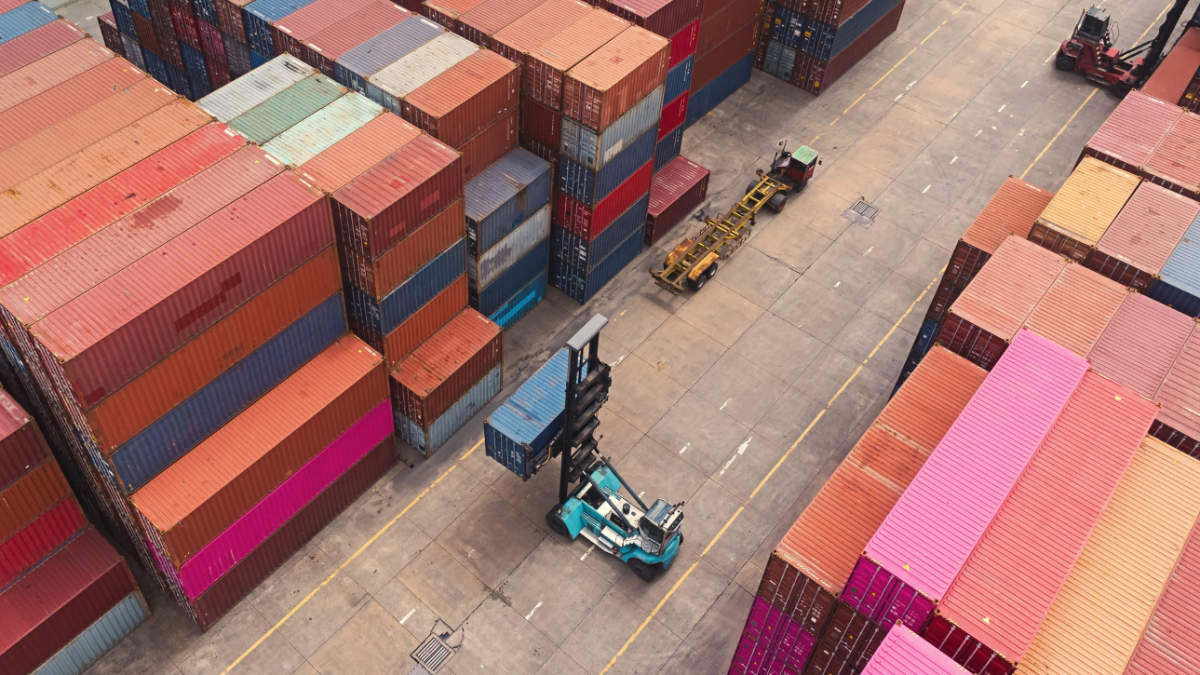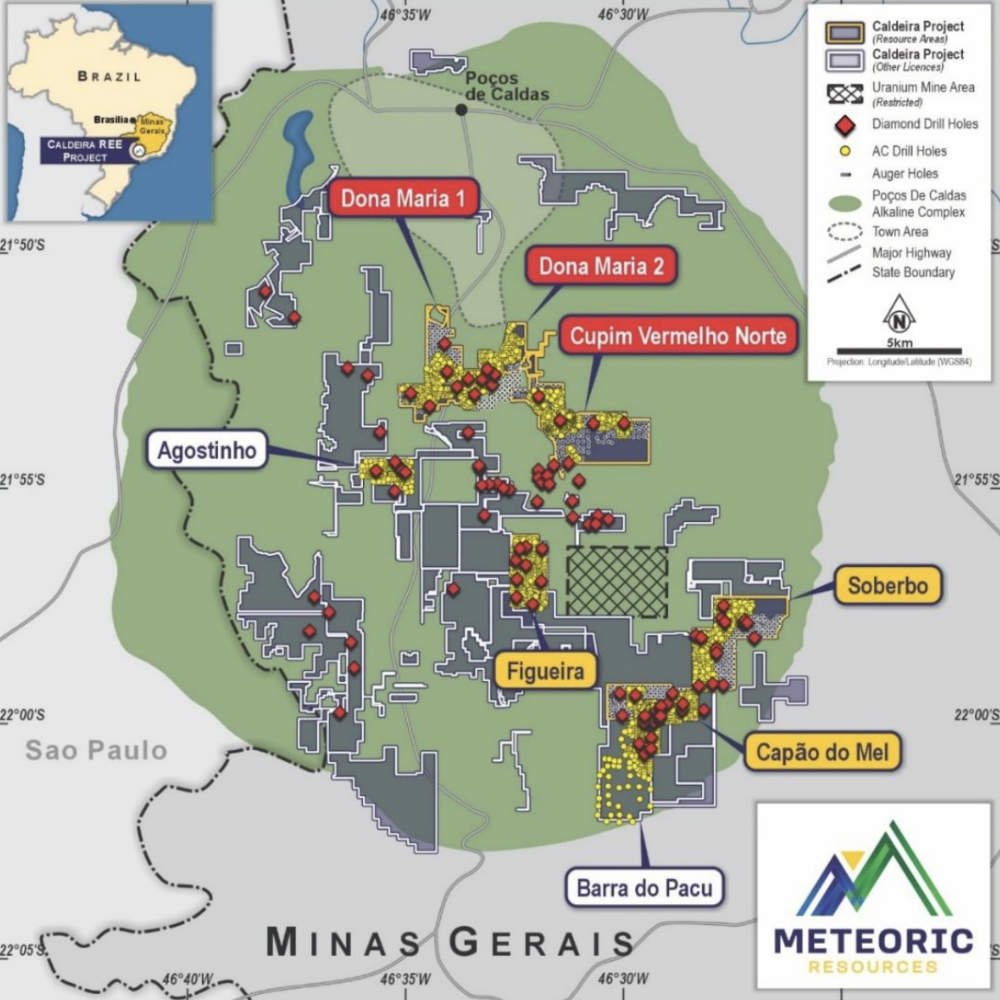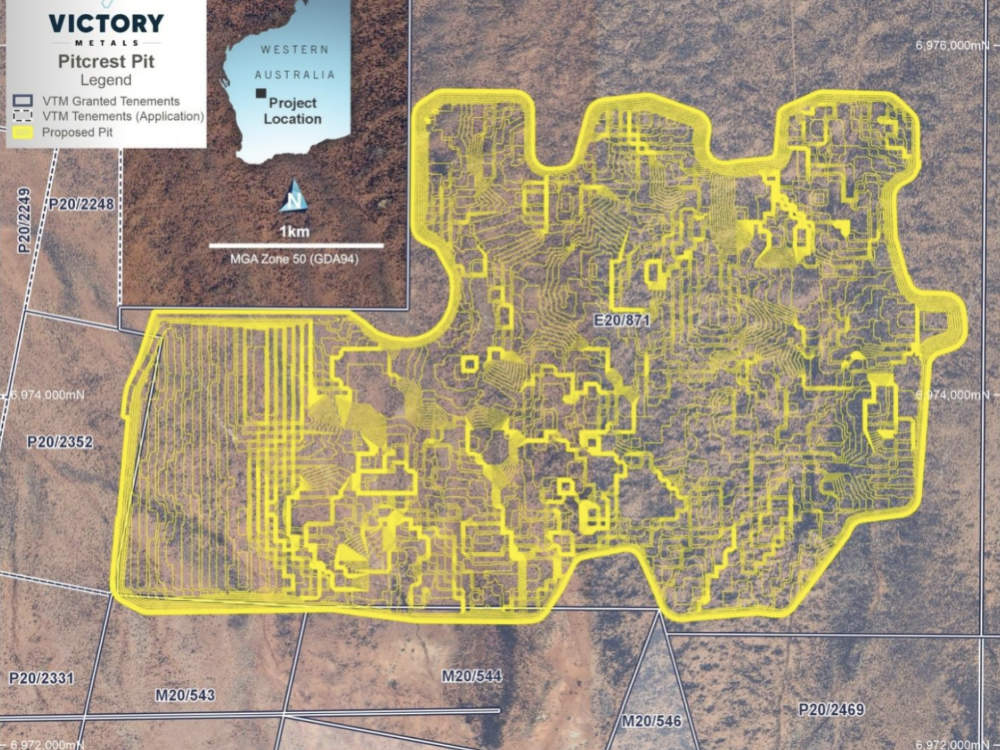China’s export restrictions highlight Western miners ready to produce heavy rare earths

REE supply chains are likely to be disrupted by China's export restrictions. Pic: Getty Images
- China places restrictions that could slow down exports of medium and heavy rare earths such as terbium
- Move comes at a time when the supply of these valuable critical minerals is uncertain
- Highlights the importance of diversifying supply from China to safe and friendly jurisdictions
China’s decision to place export restrictions on a range of medium and heavy rare earth elements has placed the attention on companies and countries with the potential to become alternative suppliers of the critical minerals.
While the restrictions on samarium, gadolinium, terbium, dysprosium, lutetium, scandium and yttrium, which were likely placed in response to the US raising tariff rates on Chinese goods to 54%, aren’t outright bans per se, they may very well slow down exports.
Canaccord Genuity analysts led by Reg Spencer said in a note that the restrictions, which come at a time when the supply of feedstocks from Myanmar is reportedly uncertain due to an ongoing civil war, will be disruptive to global REE supply chains.
Restrictions on samarium, dysprosium and terbium will likely have the largest impact as they are used in the manufacture of permanent magnets that improve heat resistivity and maintain magnetic strength in high performance applications such as electric vehicle motors and wind turbines.
Spencer and his team also believe export restrictions are likely to impact Japan more than US, with the latter having only a very small magnet manufacturing base.
Likewise, Europe is a much larger export market for Chinese permanent magnets.
“That said, we think these export controls are likely to be disruptive to global RE supply chains,” they said.
The bosses of numerous rare earth miners and explorers are sounding the alarm that the export controls show how fragile the current supply chain is of commodities critical to the future of key industries like defence, transportation and energy.
“Regardless of whether the controls directly restrict exports of MREEs, MREOs, or magnets, the move reinforces global concerns around China’s dominance of the rare earth supply chain—and the reality that it can be “weaponised” at any moment,” Perpetual Resources (ASX:PEC) executive chairman Julian Babarczy told Stockhead.
Australian Mines (ASX:AUZ) chief executive officer Andrew Nesbitt added that the new restrictions are expected to significantly tighten supply of REEs to international markets and will increase price volatility and highlight the importance of diversifying supply from China to safe friendly jurisdictions.
Meanwhile, Meteoric Resources (ASX:MEI) managing director Stuart Gale said while it was still too early to say definitively what the impacts will be, the reality was the products identified are all very important for electrification, electric vehicles, defence and consumer goods.
While markets were poleaxed by the blunt force of Trump’s tariffs on Monday, a handful of rare earth stocks with exposure to the heavies focused on by China’s controls were in the green on Monday, including Lynas (ASX:LYC), Arafura Rare Earths (ASX:ARU) and Meteoric, which rose between 3-5%. Northern Minerals (ASX:NTU), which owns the strategic dysprosium and terbium rich Browns Range deposit, finished even.
Heavy hit
Victory Metals (ASX:VTM) survived Monday’s wipeout largely unscathed, with its North Stanmore project in WA’s Murchison region potentially a major Western source of terbium and dysprosium, with gadolinium, lutetium, samarium, and yttrium also among the controlled metals in its heavy rare earths assemblage.
“China’s decision to impose export controls on key heavy rare earths like dysprosium, terbium, and yttrium sends a very clear message that the West cannot rely on China being a stable supplier of these critical minerals that are critical for our national security,” its CEO and executive director Brendan Clark told Stockhead.
“China has depleting heavy rare earth resources and I expect this problem to continue escalating not just now over several decades.”
Clark said the April 4th decision was “foreseeable” and that Western governments now needed to deliver real action to bring ex-China rare earths projects online.
“While it has certainly sparked additional interest in our project, and we remain open to new engagement, our focus continues to be on progressing several ongoing strategic relationships,” he added.
“In the long term, the reality is that everyone will be impacted if more heavy rare earth projects aren’t brought online urgently. The demand outlook significantly outweighs available supply, and once you factor out China as a reliable source, the gap becomes even more alarming.”
Reducing dependency on China
Perpetual’s Babarczy added the newly announced export controls come at a sensitive time for the global magnet rare earths industry.
“With prices hovering near cyclical lows, investment in new REE supply – particularly outside China – has stalled. This has left the world heavily dependent on China, which still accounts for around 90% of global rare earth oxide (REO) production,” he said.
Any slowdown in Chinese exports will heighten supply risks for non-Chinese buyers of Magnet REEs, REOs, and REE-based magnets.
“As a result, we expect a growing push from these buyers to diversify supply chains and support the development of new mining projects. This could act as a catalyst for non-Chinese rare earth developers to secure funding and advance toward production, helping to rebalance the market over time.”
Nesbitt expects the restrictions to result in increased support from governments with regards to permitting and funding.
Gale adds that the logical response will be to secure new, long-term, low cost rare earth supply from alternative projects in reliable jurisdictions.
“There is lot of uncertainty in the market and China’s imposition of controls will limit supply of rare earth materials that are critical across many industrial applications which will have implications for rare earths prices,” he said.
Here are some ASX-listed companies that are advancing their respective REE projects to capitalise on these developments.
Ark Mines (ASX:AHK)
Ark Mines’ Sandy Mitchell project in Queensland currently has a high confidence measured resource of 71.8Mt at 1732.7ppm monazite equivalent, a mineral containing REEs.
Exploration could bolster that further, with an exploration target set of 1.3 billion tonnes to 1.5 billion tonnes at 1286 to 1903 ppm MzEq.
A scoping study released in December has placed a $120-150m cost on a development underpinned by the current measured resource.
This is expected to generate annual EBITDA of $45m-$53m, and annual post-tax free cash flow totalling ~$25m-30m, while payback is expected within 3-4 years from first rare earth mineral concentrate production.
Ease of mining is another advantagem with the project featuring surface mineralisation with minimal topsoil and no overburden.
Processing is expected to be simple with in situ processing using gravity only, with no chemicals, salts or acids required.
This also eschews the need for tailings dams and waste piles, making mining both more economic and environmentally friendly.
Australian Mines (ASX:AUZ)
Australian Mines holds the Jequie REE project in Brazil close to Gina Rinehart-backed Brazilian Rare Earths’ (ASX:BRE) Rocha da Rocha project.
In February 2025, the company noted its 72-hole auger drilling program over two priority REE-in-soil targets returned results such as 15m at 1720ppm total rare earth oxides, including 3m at 3055ppm TREO.
Around 69% of the assays returned TREO values greater than 400ppm and a depletion of cerium, a strong indication that the REE enrichment is likely related to ionic clay adsorption.
The company has identified targets for follow-up exploration to expand the known footprint of TREO enrichment namely at the North Dário Meira Eluvial and South Dário Meira Eluvial areas.
It plans to carry out additional exploration that may include geological mapping, geochemical sampling and auger drilling as well as metallurgical testing to gain a better understanding of its exploration potential.
Besides its REE project in Brazil, AUZ also holds the Flemington project in New South Wales, one of the highest-grade scandium projects globally, with a resource estimate of 6.3Mt at 446ppm scandium.
This has the potential to expand to 28Mt at 217ppm scandium when using a 100ppm cut-off.
Scandium is used in the hydrogen economy, and to improve the performance of semiconductors and advanced communications technologies like 5G.

Axel REE (ASX:AXL)
Also operating in Brazil is AXL with its Caladão and Caldas projects, where drilling has returned strong REE results.
At Caladão, drilling has returned consistent, thick rare earth results, increasing the mineralised drilled area by 68% to over 60km2, which represents just 15% of the project area.
Standout results are 14m at 3921ppm TREO from 1m and 37.37m at 2774ppm TREO from 7m along with significant gallium from surface.
Drilling at Caldas has also logged thick and consistently high-grade intercepts from surface with an average assay of 3229ppm TREO.
In March, the company executed multiple memorandum of understandings with the Minas Gerais state government to fast track development of the two projects.
This includes a MoU with Federation of Industries Minas Gerais, which owns and operates the LabFab ITR, the first rare earth magnet research and production facility in South America.
Another MoU was signed with the State Economic Development Department and Invest Minas to support project development and fast-track licensing and approvals.
AXL is continuing maiden resource calculation at Caladão.
Meteoric Resources (ASX:MEI)
Rated a speculative buy with a 35c price target by Canaccord, Meteoric reiterated in an announcement on Monday, April 7, that its Caldeira ionic clay project in Brazil would be able to produce significant amounts of the very REEs that China has just placed restrictions on.
In its October 2024 scoping study, the company estimated the project could produce 170t of samarium, 10t of terbium and 60t of dysprosium in the first year of production.
This will increase significantly to 1190t of samarium, 90t of terbium and 430t of dysprosium in the sixth to tenth years of production.
Pre-tax NPV and IRR for Caldeira is estimated at US$1.4bn and 40.4% respectively while annual operating costs average US$5.33/kg of total rare earth oxides in the first five years and US$6.74/kg over the life of mine.
Caldeira has a global resource of 619Mt at 2538ppm TREO with 5000t of terbium oxide and 25,000t of dysprosium oxide.

There is also significant exploration upside.
“The Caldeira Project has a huge and growing resource base. It is in a great location and we are working very hard to develop the project as quickly as we possibly can to provide those critical rare earth materials,” Gale said.
He noted the near-term milestones include a resource upgrade, pre-feasibility study and environmental approvals.
“We are also looking at construction of a pilot plant for Caldeira, which will assist in the project development and provide a trial mixed rare earth carbonate product for our offtake partners and potential new customers.”
Gale added that even prior to China’s move to restrict exports, MEI already had a number of parties interested in its project.
Perpetual Resources (ASX:PEC)
Boss Julian Babarczy says the company is seeing growing interest in its Raptor REE project, located within the Caldeira Complex in Minas Gerais, Brazil.
“The Caldeira Complex is the world’s largest known source of ionic adsorption clay (IAC)-hosted rare earths outside China and is emerging as a potentially critical supplier of dysprosium (Dy) and terbium (Tb),” he said.
“Given its high MREO grades and strategic location, we believe Raptor and the broader Caldeira region are well-positioned to become a key part of the diversified rare earths supply chain the world is now urgently seeking.”
Raptor cover 318 hectares within the 800km2 Poços de Caldas Alkaline Complex with mineralisation contained in nepheline syenite and related alkaline intrusives formed during major magmatic events.
Maiden drilling PEC had returned assays such as 5m grading 5591ppm TREO ending in 5533ppm TREO and 12m at 4601ppm TREO from 6m that ended in 3846ppm TREO.
He added the recent confirmation that Raptor hosts true IAC mineralisation has significantly enhanced its development potential.
IAC rare earth projects are very highly sought after due to their potential to deliver low-cost, high-margin operations despite their relatively low grades.
Operations are characterised by simple mining and processing methodology, non-radioactive products and waste, as well as attractive mineralogy and saleable product composition, which is weighted towards the valuable MREEs.
“With our exploration manager now based full-time in Minas Gerais, we are planning for the next phase of drilling at Raptor as well as our other projects in the region,” Babarczy said.
“The next campaign will support the company’s pathway toward delivering a maiden mineral resource estimate, which is possible as early as late calendar year 2025.
“This will mark a major step in unlocking the value of what we believe is a compelling and strategically located IAC rare earth asset located outside of China.”
Red Metal (ASX:RDM)
Queensland explorer Red Metal is feeling confident it can meet a global hunger for rare earths with its large-scale Sybella deposit in the State’s north, 20km southwest of the iconic mining town of Mt Isa.
Sybella currently hosts an inferred resource of 4.79Bt at 302ppm NdPr and 28ppm DyTb, including a weathered granite section of 788Mt at 297 ppm NdPr and 28 ppm DyTb.
Earlier this year, infill drilling at Sybella showed a continuity in mineralisation. Standout assay results from the deposit’s eastern Kary Zone included 60m at 336ppm NdPr, 34ppm DyTb from surface to end of hole, and 108m at 349ppm NdPr, 38ppm DyTb from 12m to end of hole.
“Confirming the continuity for the wide zones of higher-grade REO mineralisation at Sybella is an essential step towards realising its potential for bulk tonnage heap leach mining,” Red Metal managing director Rob Rutherford recently said.
First leaching results on the weathered granite has achieved extraction rates greater than 70%. At the time of writing, Red Metal’s market cap sat just under $40 million.
St George Mining (ASX:SGQ)
SGQ recently unveiled a maiden resource of 41.2Mt grading 0.68% niobium and 40.6Mt at 4.13% TREO (including 0.74% MREO) for its Araxá project in Minas Gerais.
This includes a higher confidence indicated resource of 7.37Mt at 4.76% TREO (including 0.9% MREO) and top confidence measured resource of 1.9Mt at 5.44% TREO (including 1.04% MREO), and is contained entirely within the open pittable weathered profile.
The weathered mineralisation is free-digging, supporting potential for low-cost open-pit mining.
Bench-scale metallurgical testing is underway to assess the amenability of the project’s mineralisation to traditional flotation processing and the potential to enhance that process using new technologies.
These studies aim to define flotation parameters and recovery rates, which will guide future strategies for potential mine development and the commercial production of niobium and rare earths products as well as by-products such as magnetite, phosphate and barite.
Araxá has excellent potential for resource expansion with high-grade mineralisation remaining open in all directions.
Significant exploration potential is also demonstrated below 100m from surface and in deeper fresh rock.
The company plans to carry out significant drilling in 2025 to expand the resource and convert inferred resources to a higher confidence category that will further support ongoing development studies for a potential mining operation.
VHM (ASX:VHM)
VHM is aiming to produce REEs from its Goschen project in Victoria from December 2026.
The mineral sands and REE project has a reserve of 210Mt and a resource of 892Mt at 3% heavy minerals that also hosts dysprosium and terbium.
Under its phased development plan, pre-production capital costs for stage one were forecast at $160 million.
Stage one is expected to produce 4300tpa of rare earth mineral concentrate and 69,000tpa of zircon/titania heavy mineral concentrate at an operating cost of $77m per year from a 1.5Mtpa operation using a modular plant.
This will allow for a self-funded expansion to 5Mtpa in two years.
Capital costs for the expansion are $85-90 million, which will increase production to 9000tpa of rare earths and 134,000tpa of HMC for at least 19 years.
Goschen has pre-tax NPV of $1.64bn and an IRR of 65%.
Chief executive officer Ron Douglas told Stockhead the company is focused on delivering to the market dysprosium and terbium, which are vital for high performance in energy production, the robotic future of the care industry and defence.
Victory Metals (ASX:VTM)
The export controls on terbium reinforce VTM’s push to progress its North Stanmore project near Cue, Western Australia, which has an indicated and inferred resource of 247.5 million tonnes grading 520 parts per million total rare earth oxides.
Critically, heavy rare earth oxides such as terbium and dysprosium make up a consistent 38% of the TREO in the indicated resource of 176.5Mt at 503ppm TREO.

VTM has also proven its ability to leach rare earths out of the clay mineralisation at the project with average recoveries of 92-93%.
Its chief executive officer Brendan Clark had told Stockhead in late March 2025 that projects such as North Stanmore could give Australia a real advantage during trade discussions as there are no substitutes for the REEs it can produce.
He added that the West needed to start looking at magnet manufacturing outside of China.
At Stockhead, we tell it like it is. While Victory Metals, Red Metal, Ark Mines, VHM, Australian Mines, Perpetual Resources, St George Mining and Axel REE are Stockhead advertisers, they did not sponsor this article.
Related Topics
SUBSCRIBE
Get the latest breaking news and stocks straight to your inbox.
It's free. Unsubscribe whenever you want.
By proceeding, you confirm you understand that we handle personal information in accordance with our Privacy Policy.








